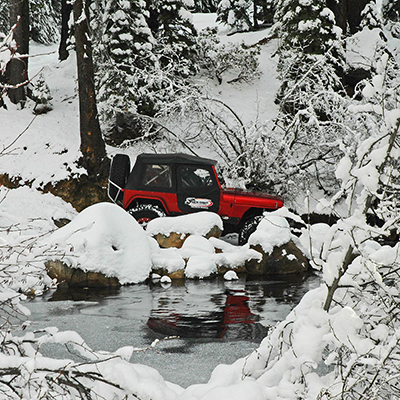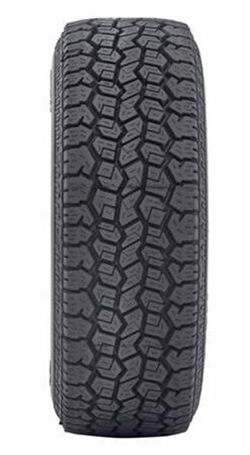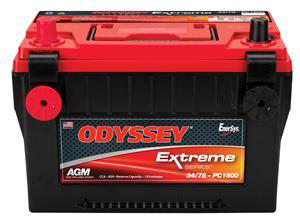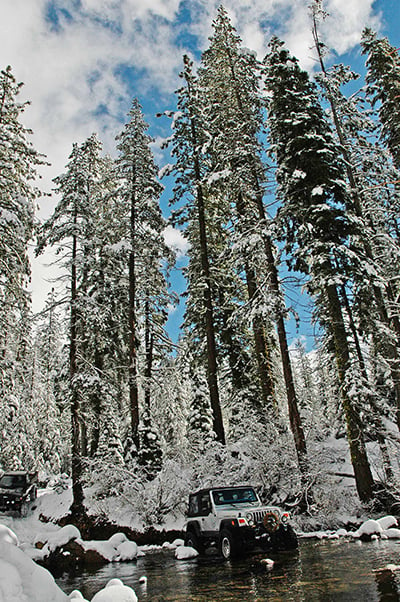Winter Wheeling Wisdom
Tips for Off-Roading in the Snow
In this Article
The snow poses a unique and exhilarating set of challenges for any off-roader – it transforms well-known trails into completely new territories, fills in some of the most difficult obstacles and makes once easy paths into slick, challenging terrain. For these same reasons, winter time off-roading can be extremely dangerous for even the most experienced driver if they are unprepared. From packing the right gear and installing the appropriate recovery hardware to knowing how to handle your Jeep in the snow and what to do if something goes wrong, you need to be armed with the right information and Jeep parts to get you through the run and back into your cozy living room.
Gear & Accessories for the Snow
While the gear you pack will vary depending on the type of vehicle you’re driving, your location and your personal preferences, there are a few staples of winter off-roading which apply across the board. Whether you’re in an XJ or a Ford, in California or Pennsylvania, you need to make sure your 4x4 is equipped with …
When driving through the snow on the road, you want narrow tires with high contact pressure that can cut through the snow to the asphalt beneath. When you’re off-roading, however, you want to make sure that you have wide base, low pressure tires to help you stay on top of the snow. You’ll need a set of siped tires with a hefty tread for maximum traction in slippery conditions.
Invest in a set of snow chains or winter tires. If you only have two chains, put them onto your rear tires, as the extra traction can cause you to fishtail if you’re braking and the chains are mounted up front. Your tires should feature aggressive tread designs which extend into the sidewall for maximum traction at low psi, deep-voided lugs and reinforced sidewalls for protection against punctures and piercing. Because the snow can mask all types of obstacles, the reinforced sidewalls are extremely useful when wheeling in winter. The last thing you want is a flat in the middle of nowhere when it’s below freezing.
A Good Winch
Any experienced off-roader will tell you that it’s not if but when you will get stuck on the trail. If you wheel in the winter, “when” is a lot sooner and more often than you might hope. A good winch can drag you out of just about any situation and get you back onto the trail in no time.
Choosing the right winch is all about knowing your vehicle and what options are out there. You need to know what sort of power and speed you need for your 4x4, as well as what sort of material the line should be. Smittybilt offers a well-reviewed line of Gen2 waterproof winches with a variety of options like available, if you’re looking for somewhere to start.
Survival Equipment
More than during any other season, it is vital that you bring the right survival supplies with you on a winter off-roading trip. While the risk of getting lost or stranded in the wild is always present, rarely is it ever so life threatening than in freezing, wet January conditions. This is important even if you live in a place without snow, as even South Texas gets exceptionally brisk at night. If something goes wrong, you need to have, at the very least:
- Enough food and water for everyone for at least 48 hours
- Dry wood and shelter – your vehicle will become an all-too-literal ice box as soon as your fuel runs out and the heat cuts off
- All-weather space blankets to conserve your body heat
- A radio or satellite phone to call for help
Maintenance
When driving in cold weather and snow, your vehicle has different needs than summertime driving. It’s important to keep your Jeep running in tip top shape throughout the winter by …
Replacing Your Fluids
Even if your 4x4 is only your daily driver and you’re not taking it onto any trails during the winter, it’s important that you change out your fluids before the first frost. Check the potency of your antifreeze, change to a lower-viscosity winter weight oil and, if you live in the far-flung north, consider getting an oil pan heater. Another important tip is to not only fill up your windshield washer fluid with anti-freeze style solution but also to run it through the lines, otherwise the remaining fluid in the lines can freeze solid and doom you to a winter of gas station squeegeeing.
Checking Your Battery
The efficiency of a vehicle’s standard lead-acid battery will be lower in colder weather, both because it cannot produce as much energy in the cold (the chemical reactions that generate electricity are slower) and because the colder, thicker oil makes the engine more difficult to turn over. You want to be sure you can start your rig, so seriously consider replacing your battery before Jack Frost rounds the corner if it’s more than five years old.
If you are looking for a good winter battery, ODYSSEY produces a line of them designed for high performance at temperatures as low as -40° F. ODYSSEY batteries can pull this off because, unlike traditional batteries, they run on a dry cell design and avoid the complications of performing chemical reactions in the cold.
Keeping it Cool
Even though it’s too cold for comfort outside, if you’re off-roading in the snow you need a good cooling system to prevent your vehicle from overheating. Because snow creates more resistance, the engine needs to push harder and can generate too much heat in the process. The issue is made even worse if you are traveling through deep snow, which can clog airflow through your radiator.
Handling
All of the summer off-roading guidelines still apply, but when you’re on the trail in the colder months, there are a few extra handling tips you should know. Driving on the pavement is one thing, but a snowy trail needs a rulebook all its own. When you’re off the grid in the winter, you need to …
It’s never a good idea to hit the trail without at least one other vehicle with you – not if it’s a comfortable summer day and especially not if it’s a freezing winter one. Even if you do everything right, Murphy’s Law can still sneak up and bite you right where it counts.
If something happens to you or your Jeep, having another vehicle there can literally save your life.
Know Your Snow
Are you trekking through fresh, light powder or several inches of heavy wet packing snow? Has the weather warmed recently, then gotten rapidly cold again – making the snow crusty and icy? It’s important that you know what sort of snow you’ll be driving through so you can handle your vehicle appropriately.
For instance, if the snow is deep and powdery, you can be sure your tires are going to cut through. You need to know there is solid ground to dig into for traction within 5-6 inches and be aware that there are hazards hiding beneath the powder. You are more likely to be able to drive on top of heavy, wet snow but you are also more likely to get stuck in it if you do cut through and it packs around your tires, leaving them to spin uselessly.
To complicate matters a bit further, the snow may be one way when you’re driving out and another when you’re coming home as the afternoon sun warms the ground and melts the top layer. While an icy crust may hold the weight of your Jeep when you set out in the morning, it may have melted away by the time you’ve turned around to go home.
Maintain Momentum … Cautiously
Momentum is a key ingredient to a successful off-roading expedition in the snow. Like Wile E. Coyote stopping to look down then falling through the air, stopping is how you sink down into the snow. By keeping a steady momentum going, you can “float” on the surface of the snow much easier.
However, your vehicle will handle differently in the snow than in any other weather and you’re driving on ever-changing terrain which you can’t see, so always remain aware and err on the side of caution when it comes to your speed.
If you go down a hill, make sure you’ll be able to get back up before you clear the crest and begin your descent. Take it slow when you are going up hills as rapid acceleration can cause your tires to spin. If you do get stuck, do not spin your tires: not only will you dig in deeper, but the heat can actually melt a layer of snow around your tires, which will then freeze again and trap you in place.
Off-roading in the snow can make for a lot of fun, but it’s important that you stay safe and are prepared if something does go wrong. Exercise caution and travel with a buddy so you know you and your Jeep will make it home safely.
Join our mailing list to receive information on new products, special events, discounts and more!
Sign up to receive deals by email!
Sign up to receive text alerts about new product releases, exclusive access to sales, and much more!
Sign up to receive deals by text!
By submitting, you agree to receive recurring autodialed marketing text msgs (e.g. cart reminders) to the mobile number used at opt-in from 4 Wheel Parts (4WP) on 21208. Consent is not a condition of purchase. Msg frequency may vary. Msg & data rates may apply. Reply HELP for help and STOP to cancel. See Terms and Conditions & Privacy Policy












